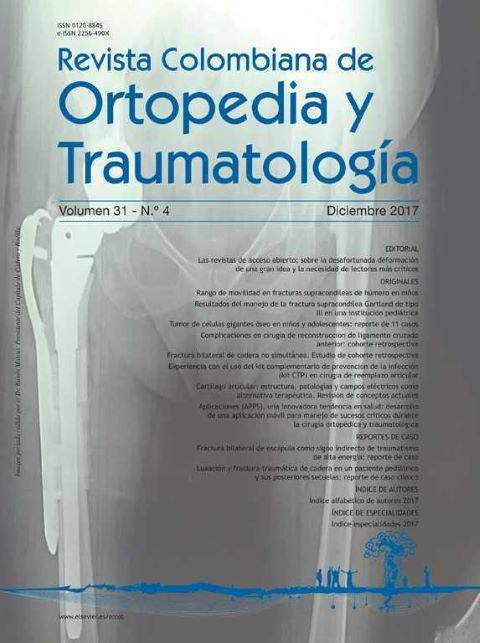Range of mobility in supracondylar humerus fractures in children
DOI:
https://doi.org/10.1016/j.rccot.2017.06.004Keywords:
supracondylar fracture of humerus, range of motion, Flynn criteria, Kirschner wiresAbstract
Background: The supracondylar humerus fractures remain the focus of Traumatology and Orthopaedics Specialists worldwide due to their high incidence in the first decade of life, as well as the variety of medical treatments used for its resolution.
Materials and methods: A cross-sectional, prospective, analytical study was conducted with the aim to assess the range of motion in supracondylar humeral fractures in children after 4 weeks follow-up, according to the criteria of Flynn, in the Ruiz y Páez Trauma Hospital between February 2012 and February 2013. To do this, a tool was prepared that included all the study variables, range of motion, type of fracture, hospital stay, and surgical treatment, with the Pearson 2 test being used for the statistical analysis.
Results: Excellent results were found in 71.43% of cases, good in 17.86%, and poor in 10.71%. Poor results were mostly associated with the Gartland type III fractures group, of which 7.14% had a hospital stay between 5-9 days, and most of them were treated with an open reduction an internal fixation.
Discussion: We conclude that supracondylar humerus fractures are likely to achieve excellent results according to the criteria of Flynn when they are treated by closed reduction and internal fixation, if they are treated within the first 48 hours after the trauma and when there is an established institutional treatment protocol for reducing complications.
Evidence level: II.
Downloads
References
Tanno M, Tanaka H, Mukai E, Hayashi Y, Takenouchi K. Supracondylar and condylar fracture of the humerus. Clin Calcium. 2008;18:1332-8.
Korompilas A, LyKissas M, Mitsionis A, Kontogeorgakos V, Manoudis G, Beris A. Treatment of pink pulseless hand following supracondylar fractures of the humerus in children. Int Orthop. 2009;33:237-41. https://doi.org/10.1007/s00264-007-0509-4
Zamorano H, Gallón L, Echandía C. Evaluación del tratamiento y complicaciones en fracturas supracondíleas de húmero distal en el Hospital Universitario Del Valle. Rev Col Ort Traum. 2006;20:36-45.
Balakumar B, Madhuri V. A retrospective analysis of loss of reduction in operated supracondylar humerus fractures. Indian J Orthop. 2012;46:690-7. https://doi.org/10.4103/0019-5413.104219
Brubacher J, Dodds S. Pediatric supracondylar fractures of the distal humerus. Curr Rev Musculoskelet Med. 2008;1:190-6. https://doi.org/10.1007/s12178-008-9027-2
Meza J. Fractura supracondílea humeral en niños. Ortho-tips. 2009;5:218-24.
De la Fuente R, González M, García L. Experiencia clínica en el tratamiento de fracturas supracondíleas del húmero en niños. Rev Mex Ort Traum. 2004;6:28-32.
Ersan O, Gonen E, Arik A, Dasar U, Ates Y. Treatment of supracondylar fractures of the humerus in children through an anterior approach is a safe and effective method. Int Orthop. 2009;33:1371-5. https://doi.org/10.1007/s00264-008-0668-y
Maity A, Saha D, Sinha D. A prospective randomised, controlled clinical trial comparing medial and lateral entry pinning with lateral entry pinning for percutaneous fixation of displaced extension type supracondylar fractures of the humerus in children. J Orthop Surg Res. 2012;7:6-10. https://doi.org/10.1186/1749-799X-7-6
Green D, Widmann R, Frank J, Gardner M. Low incidence of ulnar nerve injury with crossed pin placement for pediatric supracondylar humerus fractures using a mini-open technique. J. Orthop Trauma. 2005;19:158-63. https://doi.org/10.1097/00005131-200503000-00002
Holgado E, Tomé F, Ruiz N. Revisión de los resultados a los 10 años del tratamiento quirúrgico de las fracturas supracondíleas de húmero en el niño, tratadas mediante reducción abierta y fijación interna. Rev Orto Traumatol. 2012;56:361-8. https://doi.org/10.1016/j.recot.2012.05.006
Sven Y, Jonas F, Gunnar G, Port N, Lars E. Deformity and functional outcome after treatment for supracondylar humerus fractures in children: a 5- to 10-year follow-up of 139 supracondylar humerus fractures treated by plaster cast, skeletal traction or crossed wire fixation. J Child Orthop. 2010;4:445-53. https://doi.org/10.1007/s11832-010-0274-6
Lee S, Park M, Chung C, Kwon D, Sung KH. Consensus and different perspectives on treatment of supracondylar fractures of the humerus in children. Clin Orthop Surg. 2012;4: 91-7. https://doi.org/10.4055/cios.2012.4.1.91
Tiwari A, Kanojia R, Kapoor S. Surgical management for late presentation of supracondylar humeral fracture in children. J Orthop Surg. 2007;15:177-82. https://doi.org/10.1177/230949900701500211
Barlas K, George B, Hashmi F, Bagga T. Open medial placement of Kirschner wires for supracondylar humeral fractures in children. J Orthop Surg (Hong Kong). 2006;14:53-7. https://doi.org/10.1177/230949900601400112
Oztürkmen Y, Karamehmeto˘glu M, Azboy I. Closed reduction and percutaneous lateral pin fixation in the treatment of displaced supracondylar fractures of the humerus in children. Acta Orthop Traumatol Turc. 2005;39:396-403.
Zionts L, Woodson C, Manjra N, Zalavras C. Time of return of elbow motion after percutaneous pinning of pediatric supracondylar humerus fractures. Clin Orthop Relat Res. 2009;467:2007-10. https://doi.org/10.1007/s11999-009-0724-y
El-Adl W, El-Said M, Boghdady G, Ali A. Results of treatment of displaced supracondylar humeral fractures in children by percutaneous lateral cross-wiring technique. Strategies Trauma Limb Reconst. 2008;3:1-7. https://doi.org/10.1007/s11751-008-0030-3
Downloads
Published
How to Cite
Issue
Section
License
Copyright (c) 2024 Revista Colombiana de ortopedia y traumatología

This work is licensed under a Creative Commons Attribution 3.0 Unported License.




